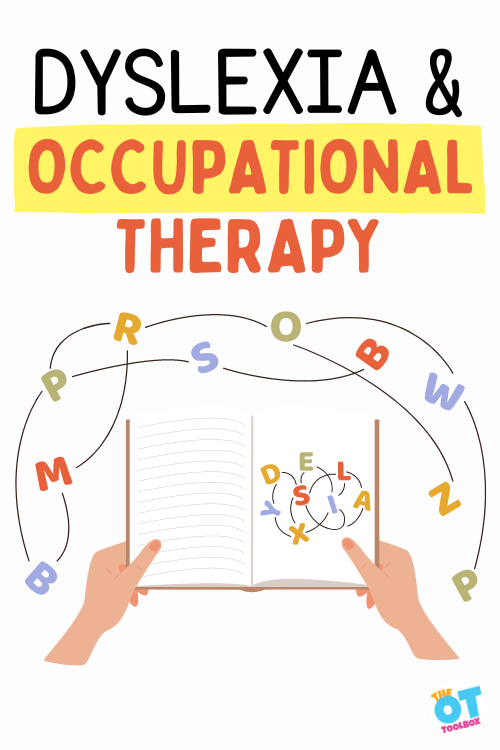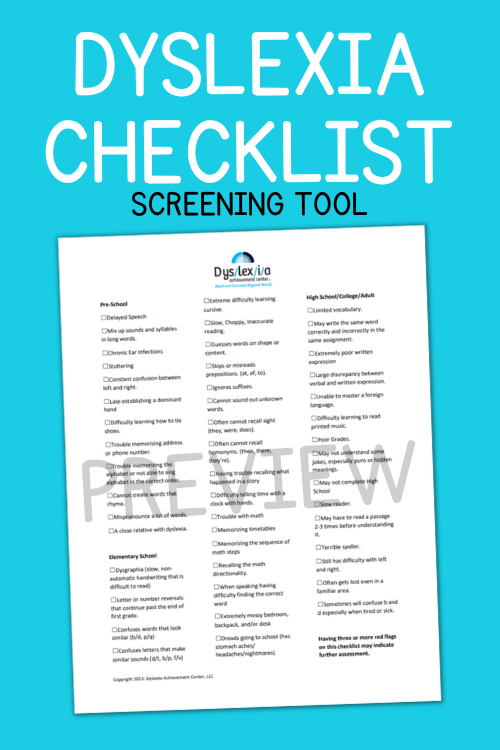In this blog post, we’re covering dyslexia occupational therapy and dyslexia resources for occupational therapy interventions. School based occupational therapy practitioners often come across diagnoses like dyslexia in their evaluations and in supporting students in the classroom environment. Let’s break down how OT can support dyslexia needs.

Dyslexia and Occupational Therapy
Occupational therapy practitioners support their clients with daily functional tasks, or occupations, and dyslexia can be one contributing factor that impairs day to day tasks.
When addressing needs that impact reading and writing, dyslexia and occupational therapy go hand-in-hand.
While OT for dyslexia is not specifically addressed in most classroom situations, the skills of an occupational therapy provider make dyslexia occupational therapy interventions a natural fit.
How can occupational therapy support clients with dyslexia?
Reading is a functional occupation. We use reading for safety, work, school, and almost every aspect in our everyday life.
Another important aspect is health literacy. How can we expect our clients to follow health advice if they cannot read the information given to them?
Everyone should have the ability to protect themselves and families. OTs need to advocate for their clients and help support them as they navigate the health system and beyond.
Because of these closely related tasks and the underlying skills that play a role in function, occupational therapy providers support clients by targeting both the underlying skills as well as the functional task. Knowing the warning signs of dyslexia can help occupational therapists identify clients that need support.
Occupational Therapists have a unique talent to identify and help students with learning differences, especially dyslexia.
According to the International Dyslexia Association 20% of the population has dyslexia. About 20-40% of students with dyslexia have a comorbidity or another diagnosis.
Occupational therapy practitioners work with clients and can identify dyslexia warning signs when there is another diagnosis present.
Clients with handwriting/dysgraphia difficulties may also have dyslexia and would benefit from identification.
The Dyslexia Checklist can help occupational therapists assist their clients in identifying warning signs of dyslexia.
Take a look at this quote about dyslexia and the contributing factors that impact overall learning in the classroom:
“Dyslexia is a specific learning disability that is neurobiological in origin. It is characterized by difficulties with accurate and/or fluent word recognition and by poor spelling and decoding abilities. These difficulties typically result from a deficit in the phonological component of language that is often unexpected in relation to other cognitive abilities and the provision of effective classroom instruction. Secondary consequences may include problems in reading comprehension and reduced reading experience that can impede growth of vocabulary and background knowledge.”
This quote comes from the International Dyslexia Association.
What is Dyslexia
Dyslexia is included as a Specific Learning Disability in this DSM-5 (Diagnostic Statistical Manual-5th edition), the reference for cognitive, emotional, and psychological disorders. As such, it is covered by The Americans with Disabilities Act. Dyslexia is usually inherited, it is lifelong, although it can be remediated with correct instruction.
Dyslexia can impact one or many of the following areas:
- Difficulty with phonemic awareness (hear, identify, and manipulate phonemes—smallest sounds in a word)
- Difficulty with phonics (correlating sounds with letters)
- Difficulty with learning to decode (break down printed word into speech)
- Difficulty learning to spell (Orthography) (write or name letters that form a word in the correct sequence)
- Difficulty with Comprehension (understanding what the words or sentences mean)
- Difficulty with Orthographic Mapping (formation of the letter-sound connections to bond spelling, pronunciations, and meanings of specific words to memory)
- Orthographic Mapping –how we store words into our long term memory. This orthographic mapping tool is a good resource.
You’ll find many more indicators listed on the printable screening support tool: The Dyslexia Checklist. This printable list of red flag indicators is a resource to use in screenings or to help identify risk factors that may impact learning, reading, and writing, as well as other functional tasks.
How to support dyslexia in OT
Best results are attained for a student with dyslexia when two circumstances occur:
- Accommodations
- Specialized Instruction such as The Science of Reading (SOR) such as Orton Gillingham
Within these two strategies, occupational therapy is a natural fit for dyslexia. Accommodations in the classroom is something the occupational therapy practitioner excels in. And features of the science of reading, Orton Gillingham or other SOR programs, include, among other tools, a multisensory approach to learning.
A student with dyslexia must ultimately build skills necessary for reading, writing, and spelling competently.
Students with dyslexia benefit from learning the English language in detail, mastering the sound/symbol correspondences, syllable patterns and this structure of our English writing system (orthography).
The student benefits when the instruction is provided in a multisensory way, relying upon not just one or two neural pathways for learning, but several simultaneously. This is known as the Science of Reading or Orton Gillingham.
Occupational therapists can use the warning signs tool to help identify client’s at risk for dyslexia. Occupational therapists can refer clients to a dyslexia specialist in their area if there are any concerns about dyslexia. Dyslexia interventionists have 60-70 hours of training and a year practicum where they are supervised by an experienced trainer. They must have at least 100 hours of supervision in order to apply for certification.
The main certification organizations include:
- OGA (Orton Gillingham Academy)
- IMSLEC (The International Multisensory Structured Language Education Council)
- ALTA (American Language Therapy Association)
Lists of qualified, certified dyslexia interventionists can be found on each of these organization’s websites.
Diagnoses with Dyslexia -Occupational Therapy Support
Some diagnoses that are common with dyslexia include:
- ADHD/ADD
- Autism
- Language processing disorders
- Dysgraphia (writing)
- Dyscalculia (math)
- Dyspraxia (coordination)
- Other learning differences
Executive functioning can be impacted with or without one of the diagnoses listed above. Specifically, executive functioning needs may be present along with dyslexia.
Additionally, executive functioning can impact learning in a variety of ways and if not addressed, may slow progress with dyslexia intervention. Occupational therapy providers have many assessments and interventions for executive functioning, which can also be used to identify specific challenges in the student with dyslexia. OT should be part of the dyslexia team to help these students succeed.
Reading supports planning and organization in our daily lives. We rely on it to decipher calendars, to-do lists, and reminders, facilitating efficient scheduling and task management. When this is difficult for our clients or their family members, we can see challenges with follow through.
The Occupational Therapy Dyslexia Connection
Reading is a functional occupation. OT providers support individuals of all abilities in participating in daily functional tasks given modifications, adaptations, and skilled interventions.
Because of the way that occupational therapists and occupational therapy assistants target daily occupations, or the tasks that take up our time, facilitating reading supports in these daily tasks is essential.
Reading is a fundamental part of daily life, influencing nearly everything we do. Reading information plays a role in how we communicate, stay informed, and learn.
In occupational therapy evaluations and interventions, it’s essential to recognize the significance of reading, especially for clients with dyslexia.
Dyslexia can make reading challenging, impacting their ability to perform tasks like following instructions for cooking, navigating through maps, or even understanding medical information. Other ways that reading challenges as a result of dyslexia may interfere with daily functional tasks, include:
- It serves as a cornerstone of communication, allowing us to understand written messages in various forms, including emails, text messages, and handwritten notes, facilitating connections and efficient responses to others.
- Reading is necessary for everyday activities such as cooking, where we read recipes to ensure accurate comprehension of measurements, instructions, and ingredient lists for preparing meals.
- Reading is vital for the IADL, shopping, enabling us to decipher labels and product descriptions, especially for individuals with dietary restrictions or allergies.
- Reading is necessary for making appointments, deciphering communication, and healthcare.
By supporting clients with dyslexia in developing their reading skills, occupational therapists empower them to participate more fully in daily life tasks, education, and work, ultimately enhancing their overall quality of life.
Occupational Therapy providers need to advocate for their clients and help them find support and resources. Knowing the warning signs of dyslexia, can help occupational therapists identify clients that need support.
For specific list of Dyslexia indicators, grab a copy of The Dyslexia Checklist.
Created by occupational therapist, Nicole Boyington, The Dyslexia Checklist is a printable tool to support therapists, interventionists, educators, and parents in identifying specific needs of the individual child.
When students struggle with reading, writing, and/or comprehension as a result of Dyslexia, many areas of function can be impacted. Reading is a complex occupation and many different aspects can be impacted. One student with dyslexia does not look like another student with dyslexia. Being able to identify red flags is important to increase literacy for all populations. The Dyslexia Checklist is a tool to support anyone working in this area.

Nicole Boyington has been an Occupational Therapist for 22 years. Residing in Wisconsin, Nicole is currently a faculty member at a local university. She has a Master of occupational therapy from St. Ambrose University and a Post Professional Doctor of Occupational Therapy from Chatham University. Nicole is the current president of the Wisconsin Occupational Therapy Association. Nicole has been tutoring students with dyslexia for the past three years and is a Certified Structured Literacy Dyslexia Interventionist. She currently owns a Dyslexia tutoring center and is on the board of the Wisconsin International Dyslexia Association.







